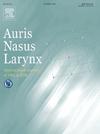单侧耳聋人工耳蜗植入术的医疗护理进展。
IF 1.5
4区 医学
Q2 OTORHINOLARYNGOLOGY
引用次数: 0
摘要
目的:探讨单侧耳聋患者人工耳蜗植入术的先期医疗护理效果。材料和方法:一项前瞻性、非随机、历史对照临床试验于2021年7月至2023年7月在一家机构进行。参与者是被诊断为单侧,严重到深度感音神经性听力损失的患者,平均听力水平在差侧超过70 dB,在好侧低于40 dB。CI手术在全麻下通过圆窗入路进行。术前及设备激活后1、3、6、12个月,采用67-S单音节表测量噪声条件下的语音识别评分,并评估声音定位能力。使用问卷对耳鸣障碍和听力障碍进行评估。结果:术前至术后12个月使用日语单音节表的语音辨别评分显著提高,术后12个月声音定位能力显著提高。调查问卷显示耳鸣障碍和听力障碍也有明显改善。所有被认为与这种治疗相关的不良事件在CI手术中都是众所周知的,并且与治疗相关的风险不被认为大于收益。结论:采用日语单音节表对单侧耳聋患者进行CI预先医疗护理,效果显著且有利,表明CI干预对单侧耳聋患者的有效性。考虑到治疗的益处大于风险,这种治疗被认为对单侧耳聋患者有效。本文章由计算机程序翻译,如有差异,请以英文原文为准。
The advance medical care outcomes for cochlear implantation in single-sided deafness
Objective
The present study aimed to show the results of the advance medical care for cochlear implantation (CI) in cases of single-sided deafness.
Materials and Methods
A prospective, non-randomized, historically controlled clinical trial was conducted at a single institution from July 2021 to July 2023. Participants were patients diagnosed with unilateral, severe to profound sensorineural hearing loss and with average hearing levels over 70 dB on the poor side and under 40 dB on the better side. CI surgeries were performed through the round window approach under general anesthesia. Preoperatively and at 1, 3, 6, and 12 months after device activation, speech discrimination score was measured using the 67-S monosyllabic list under noise conditions, and sound localization ability was also assessed. Assessments of tinnitus disturbance and hearing handicap were performed using a questionnaire.
Results
Speech discrimination score using the Japanese monosyllabic list improved significantly from preoperatively to 12 months postoperatively, and significant improvement of sound localization ability was also observed 12 months postoperatively. Tinnitus disturbance and hearing handicap according to the questionnaire were also significantly improved. All adverse events believed to be related to this treatment are well-known occurrences in CI surgery, and the risks associated with the treatment are not considered to outweigh the benefits.
Conclusion
The advance medical care with CI for single-sided deafness demonstrated a significant and favorable improvement using a Japanese monosyllabic list, indicating the effectiveness of the CI intervention for patients with single-sided deafness. Considering that the benefits of treatment outweigh the risks, this treatment was deemed effective for patients with single-sided deafness.
求助全文
通过发布文献求助,成功后即可免费获取论文全文。
去求助
来源期刊

Auris Nasus Larynx
医学-耳鼻喉科学
CiteScore
3.40
自引率
5.90%
发文量
169
审稿时长
30 days
期刊介绍:
The international journal Auris Nasus Larynx provides the opportunity for rapid, carefully reviewed publications concerning the fundamental and clinical aspects of otorhinolaryngology and related fields. This includes otology, neurotology, bronchoesophagology, laryngology, rhinology, allergology, head and neck medicine and oncologic surgery, maxillofacial and plastic surgery, audiology, speech science.
Original papers, short communications and original case reports can be submitted. Reviews on recent developments are invited regularly and Letters to the Editor commenting on papers or any aspect of Auris Nasus Larynx are welcomed.
Founded in 1973 and previously published by the Society for Promotion of International Otorhinolaryngology, the journal is now the official English-language journal of the Oto-Rhino-Laryngological Society of Japan, Inc. The aim of its new international Editorial Board is to make Auris Nasus Larynx an international forum for high quality research and clinical sciences.
 求助内容:
求助内容: 应助结果提醒方式:
应助结果提醒方式:


